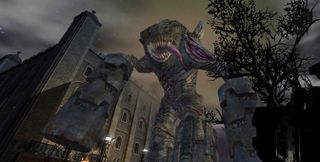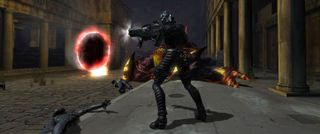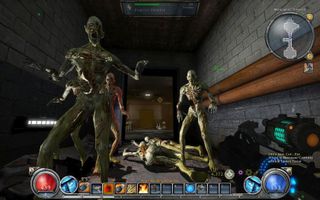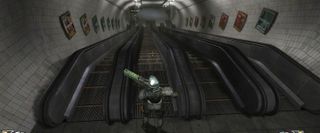
Reinstall invites you to join us in revisiting classics of PC gaming days gone by. Today, Jon Morcom revisits the gritty demon-ridden streets of Hellgate: London.
The seemingly rushed release of Hellgate: London, to coincide with Halloween 2007, was arguably a Pyrrhic victory for opportunistic marketing over what with hindsight might have been a more measured launch strategy. The mixed reviews the game received at the time suggested that Namco Bandai/EA’s hopes for a spooky season cashin had come at the expense of fully developed ideas and a varied experience. The procedurallygenerated levels were too samey, they said, the quests were repetitive errandboy stuff, and the combat lacked excitement. Living in the English capital as I do, I was curious and kind of determined to like Hellgate: London, but the general consensus was that it was more trick than treat.
Now defunct, Flagship Studios’ only full release purported to be an actionRPG imbued with a more pronounced FPS feel. Alas, the shooting wasn’t that great and the roleplaying elements were limited. However, with a number of Diablo old hands driving things, it was no surprise that amassing loot and agonising over skill and item stats would feature prominently. That might not sound enticing to hardcore shootists, but it was invitation enough for an inveterate tweaker like me.

It’s 2038 and demons intent on obliterating mankind are pouring in through Hellrifts spread throughout the capital. Enlisted to assist gaming’s perennial ‘goto’ faction, the Templars, in their crusade to eradicate the threat, you’re headed for the Hellgate inside St Paul’s Cathedral, through which you must pass to confront the final boss Sydonai.
Starting at Russell Square, your journey takes you across the London Underground, using a number of key stations as havens where the quests are dispensed by a cast of foppish dandies, intense bearded types and cheeky Cockneys. These hubs are beautifully detailed with their futuristic forges, handy gear lockers and bountiful shops run by a succession of wisecracking merchants; each contains a number of portals through which you must pass into tube tunnels or the streets above to tackle a huge variety of beasts and ghouls, most of whom upon expiry surrender some lovely Palladium, valuable hardware or a satisfying combination of both.
It’s 2038 and demons intent on obliterating mankind are pouring in through Hellrifts spread throughout the capital.
Unfortunately, most of the weapons in Hellgate have the ballistic impact of a squirt of deodorant, but with less lethal results. But this is where the game can get its claws into you. Keeping your character competitive with the demons you’re fighting as you level up means acquiring a severe gear habit and getting to grips with the excellent crafting system. It’s all about collecting guns and swords, breaking these and other high-yield items down for their scrap metal, tech and rare shards, all of which can be used at nanoforges to upgrade your weapons and armour. Additionally, you can buff an item with coins at any Augmentrex 3000 machine.
There’s infinite joy to be had in sifting through loot drops and strangely ubiquitous crates for killer mods that will complement and amplify the kind of damage your weapons are dealing. Inventory management becomes crucial with so much... stuff to gather up, sell or cannibalise; nudging those weapon and armour stats higher becomes an obsession, if not an outright necessity. Hellgate’s underlying precept is ‘always be modifying’.

London Underground aficionados will know that from the game’s starting station, Holborn, it’s only two stops on the Central Line to St Paul’s, where the final battle takes place. However, you’ll be taking the scenic route through 200 story and sidequests that play out in around 115 locations. Given the numbers involved, I can forgive Flagship for repeating a few of the dozen or so generic environments. Wide, abandoned streets, pokey alleys, dank train tunnels, cloistered courtyards and subterranean necropolises provide a somewhat impressionistic (if sometimes accurate) interpretation of London, although Flagship had a decent stab at recreating reallife locations like St Paul’s and Covent Garden Market.
The biggest gaming news, reviews and hardware deals
Keep up to date with the most important stories and the best deals, as picked by the PC Gamer team.
A notable exception to the many fetch quests is a mission that places you inside the head of Techsmith 314, exploring the winding synapses of his mind, looking for the Limit of Imagination. Another dispatches you to the Tower of London to kill the massive Beast of Abbadon. A boss with piledriver hands and a fiery breath attack, the Beast has been interrupting Templar communications. This fight requires you to first catch him in the crossed beams of two light cannons, shrinking him temporarily, at which point he spawns a dozen electricallycharged Fellbore minions. This leaves the Beast’s hitbox – about the size and location of a posing pouch – briefly vulnerable so you can pepper it with ‘nut shots’; it’s about the toughest fight in the game.

Flagship’s vision of a London that has been destroyed by The Burn and overrun by demons is a fair attempt at creating the chaos such circumstances might bring, and anyone who has spent the Saturday before Christmas shopping on Oxford Street will recognise it immediately. I love that the art style is so crisp, with a colour palette that’s not quite as drab as you might expect. The street levels are littered with abandoned police cars, burntout black cabs and upended phoneboxes. Lava erupts through the walls and the pavements are not populated with NPCs taking flight but, more entertainingly, with another gaming staple – combustible barrels. This knowing, gratuitous placement of things that go ‘boom’ and the comical way in which the cast of British eccentrics deliver the few lines they have is admirable; Hellgate never takes itself too seriously.
I think it was the 18th century writer Dr Johnson who once said that when a man is tired of Hellgate: London, he is tired of life. Alright, I admit that’s overstating things a bit—maybe the game missed some opportunities, but whether you go through it as a guntoting Marksman or a fairydust flinging Evoker, it’s an engaging experience and a bold attempt to bridge the gulf between genres. Mind the gap.
PC Gamer is the global authority on PC games—starting in 1993 with the magazine, and then in 2010 with this website you're currently reading. We have writers across the US, Canada, UK and Australia, who you can read about here.
Most Popular

